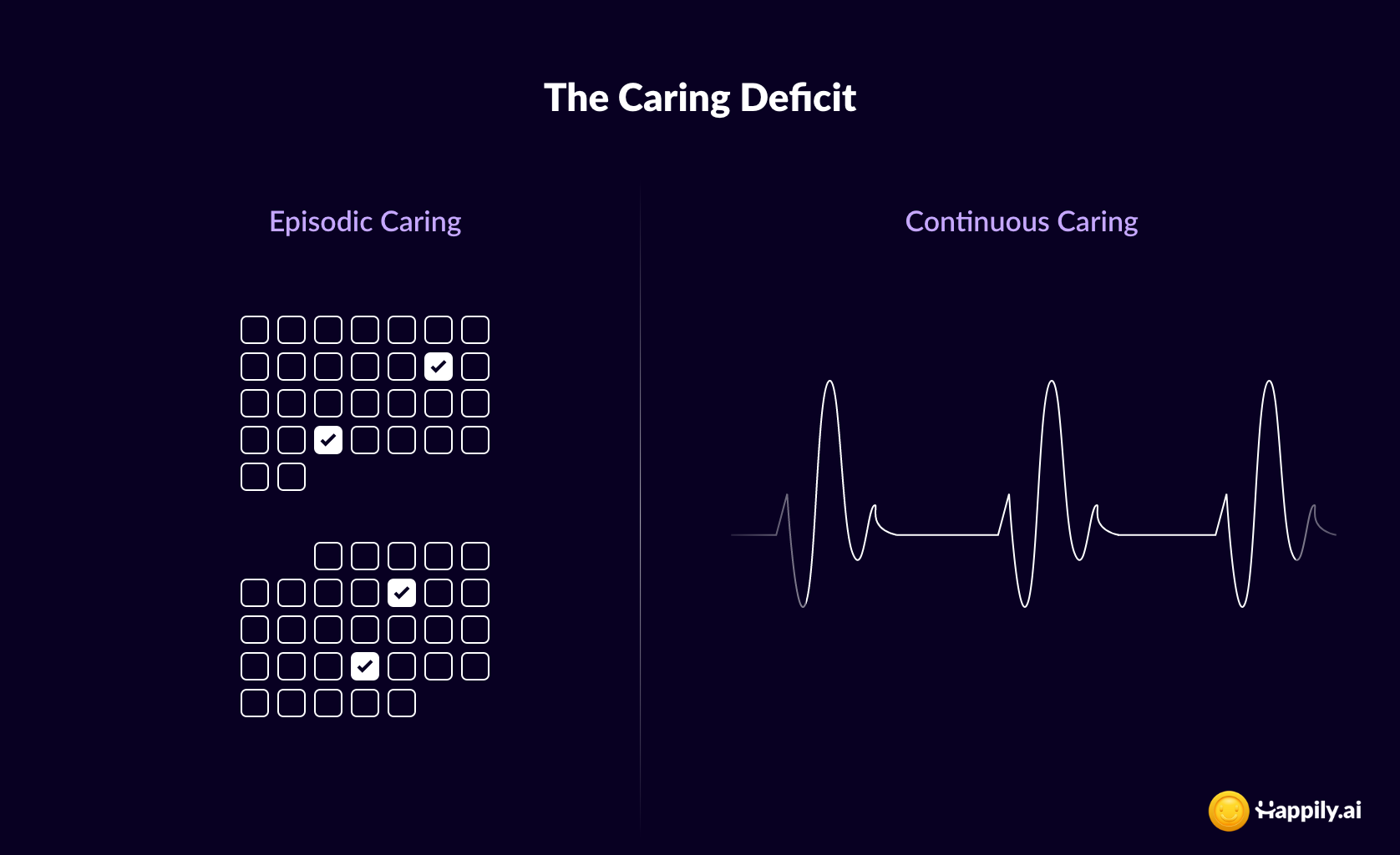What we want in organizations is remarkably simple: for people to care about their work and the people they work with.
This is what employee engagement actually measures. How much do people around here care about what they're doing and who they're doing it with? Everything else you track is downstream from that single question.
But caring breaks down in organizations. And when it does, we find ways to compensate for it. We create tools and activities that try to substitute for caring, and often undermine it further.
The Substitution Problem
Consider the most common workplace practices. Each one substitutes for something that should exist naturally in a healthy organization:
- Bonuses substitute for intrinsic motivation to do good work
- Surveys substitute for noticing how people are doing
- One-on-ones substitute for managers who stay connected to their reports
- Performance reviews substitute for the difficult work of managing someone out
- Development plans substitute for genuine investment in growth
- 360 feedback substitutes for the courage to say things directly
- OKRs substitute for alignment from shared context
- Team offsites substitute for functional team dynamics
- Values statements substitute for leadership modeling what matters
Research shows that when employees feel cared for by their organization, engagement increases dramatically. A 2021 study on caring human resource management found that a system of caring HRM practices results in an organizational climate of care and concern that employees reciprocate with higher levels of engagement (Saks, 2022). The relationship is reciprocal: when organizations genuinely care about employees, employees respond by caring more about their work and the organization.
Yet Gallup's 2024 State of the Global Workplace report reveals that only 23 percent of employees worldwide are engaged in their work, representing 4.8 million fewer engaged U.S. employees than in previous years (Gallup, 2024). This represents the lowest engagement level since 2013. The data suggests our conventional tools aren't working.
From Events to States: The Episodic Problem
The fundamental problem is that conventional tools treat caring as a discrete event rather than a continuous state. They're episodic:
- The annual survey, then wait a year.
- The quarterly review, mark your calendar.
- The scheduled 1:1, because it's Tuesday at 2pm.

Research on continuous feedback versus annual reviews consistently demonstrates the limitations of episodic approaches. Organizations that maintain annual performance reviews miss critical opportunities for growth, with feedback arriving too late to be useful (Betterworks, 2024). A comprehensive 2024 study found that only 14 percent of employees felt their annual performance evaluations provided value (Gallup, 2024).
When caring becomes bureaucratic and obligatory, it stops being caring. The checkbox replaces the thing itself.
The Cost of Episodic Caring
The financial and human costs of treating engagement as an annual exercise are substantial. Research shows that organizations implementing continuous feedback systems experience 14.9 percent lower turnover rates compared to those relying solely on traditional annual reviews (Teamflect, 2024). More striking, employees who receive regular feedback are 3.6 times more likely to be engaged at work compared to those receiving only annual feedback (Gallup, 2024).
The episodic approach creates predictable problems. Adobe's research found that 22 percent of employees have cried after a performance review, and 37 percent have looked for another job as a result of the review process (Adobe, 2023). These aren't signs of a caring organization. They're symptoms of caring compressed into high-stakes, infrequent moments that generate anxiety rather than connection.
Culture Amp's 2024 analysis of 3 million employees found that the parts of the employee experience where employees felt most "on the fence" were those around action-taking and accountability (Culture Amp, 2024). When organizations only check in periodically, employees develop neutral stances rather than genuine engagement, seeing caring as performative rather than real.
A Different Approach: Continuous Caring
There's a different approach: make caring continuous rather than episodic. This happens through ongoing, meaningful conversation.
You cannot care about someone you never talk to. Or someone you only talk to when mandated. Or someone you only notice when something's wrong.
Research supports this intuitive truth. A Gartner study found that continuous feedback increases engagement by nearly 40 percent and performance by 26 percent (Gartner, 2024). Organizations that conduct regular check-ins experience a 30 percent improvement in employee performance (Gallup, 2024). The data is clear: frequent, meaningful interaction drives both engagement and results.
Continuous caring doesn't mean constant surveillance or relentless checking in. It means sustained mutual attention. Research shows that employees who receive meaningful feedback weekly are 80 percent fully engaged, compared to only 20 percent when feedback is delayed or non-existent (ThriveSparrow, 2024). The optimal frequency appears to be weekly recognition and feedback, with more substantial developmental conversations occurring at least monthly.
What Continuous Caring Looks Like in Practice
Several organizations have demonstrated what happens when caring becomes continuous rather than episodic. Adobe replaced annual reviews with their "Check-In" system, focusing on ongoing development conversations (Adobe, 2023). Louis Vuitton adopted a continuous performance management approach that gives employees more autonomy and a more significant role in the managerial relationship (Popwork, 2024). Deloitte redesigned its performance management systems entirely, eliminating annual assessments and 360-degree feedback tools in favor of a more flexible approach (Deloitte, 2015).
The common thread in these transformations isn't the specific tool or platform. It's the shift from treating caring as an annual event to treating it as an organizational state that requires continuous cultivation.
Measuring Continuous Caring
Organizations need ways to measure organizational culture to determine whether caring is happening continuously or episodically. Behavioral indicators provide clearer insights than sentiment surveys. Rather than asking people how they feel about the organization, observe how the organization behaves:
- How quickly do managers respond when team members raise concerns?
- How often do meaningful developmental conversations occur?
- What percentage of employees report receiving actionable feedback in the past week?
- How long does it take for performance issues to be addressed?
- Are recognition and feedback distributed throughout the year or clustered around review periods?
These behavioral measures reveal whether caring is a continuous state or an episodic performance. Organizations that measure engagement through continuous behavioral data rather than annual surveys gain visibility into cultural health as it develops, not after it has already deteriorated.
This approach aligns with research showing that traditional, once-a-year surveys rarely capture the full, evolving picture of employee sentiment (Happily.ai, 2024). When feedback is gathered only annually, important shifts in morale and engagement go unnoticed until they impact performance and retention.
The Technology Question
Technology can enable continuous caring, but it cannot substitute for it. The most effective platforms don't just automate feedback cycles. They make ongoing attention easier and more natural for both managers and employees.
Happily.ai demonstrates this distinction through its approach to continuous engagement. Rather than replacing human connection with automation, the platform drives 97 percent participation through meaningful daily interactions that feel natural rather than bureaucratic. Through AI-powered daily check-ins, the platform helps organizations identify and address concerns in real-time, transforming engagement from an annual measurement exercise into a continuous practice.
Organizations using Happily.ai have seen dramatic improvements in engagement metrics precisely because the platform treats caring as a continuous state rather than a periodic event. One global luxury brand increased their employee Net Promoter Score from negative 13 to positive 84 within a year by implementing daily check-ins that created space for open dialogue and timely response (Happily.ai, 2024). The transformation came not from better surveys but from making caring continuous.
The key is implementing technology that supports genuine relationship-building rather than creating new bureaucratic obligations. The most effective continuous feedback systems feel less like performance management tools and more like natural extensions of how managers and teams already communicate.
Building Psychological Safety Through Continuous Caring
Continuous caring creates the conditions for psychological safety, which research identifies as the foundation of high-performing teams (Edmondson, 1999). When people know they will receive regular, constructive feedback, they're more likely to take risks, share ideas, and admit mistakes without fear of negative repercussions during an annual review.
Research shows that teams with high psychological safety achieve 1.7 times higher innovation rates (McKinsey, 2024). Google's Project Aristotle found that psychological safety was the top predictor of team effectiveness, with high-safety teams 67 percent more likely to report productive conflict resolution (Rozovsky, 2015).
Organizations build psychological safety through consistent action, not annual declarations. When managers provide feedback regularly, address concerns promptly, and engage in genuine developmental conversations, employees learn that caring is a continuous state rather than a performative event. This creates environments where trust and empathy become embedded in daily operations rather than aspirational values stated once per year.
The Manager's Role in Continuous Caring
Managers are the critical enabler of continuous caring. Research shows that managers account for at least 70 percent of variance in employee engagement (Gallup, 2024). This means that the quality of the manager-employee relationship has more impact on engagement than any organizational program or policy.
Yet only 84 percent of employees trust their managers (EngageRocket, 2024), and nearly 70 percent of managers experience difficulties effectively leading their teams (Cadremploi, 2024). The gap between the importance of manager relationships and managers' capability to build those relationships represents a massive opportunity.
Organizations need to invest in developing managers' capacity for continuous caring. This means training managers not just in feedback techniques but in the underlying skills that make caring continuous: active listening, genuine curiosity about employee experiences, and the ability to have difficult conversations without waiting for scheduled review periods.
The most effective manager development focuses on building relationships through frequent, low-stakes interactions rather than high-stakes, infrequent evaluations. When managers learn to check in briefly and meaningfully each week, caring becomes a natural part of the workflow rather than a scheduled obligation.
From Surveys to Conversations
The shift from episodic to continuous caring requires moving from surveys to conversations. Annual engagement surveys provide a snapshot of how people felt at a single moment, often weeks before the results are even analyzed. By the time leaders receive the data and develop action plans, the organizational reality has already shifted.
Continuous feedback enables organizations to understand employee experience as it unfolds rather than after the fact. Research demonstrates that organizations with frequent feedback mechanisms can detect potential issues early, preventing small problems from becoming larger concerns (Happily.ai, 2024). This proactive approach builds trust through transparency and ensures that every voice is heard in real-time.
The best continuous feedback systems combine structure with flexibility. They establish regular touchpoints, such as weekly pulse questions or bi-weekly one-on-ones, while allowing managers and employees to adapt the conversation to current needs rather than predetermined agendas. This balance ensures consistency without rigidity.
Closing the Action Gap
Research reveals a critical insight about engagement initiatives: insights without action is just trivia (Quantum Workplace, 2024). Organizations can improve on acting on employee feedback, with less than half of employees saying their organization consistently acts on survey results.
This action gap is particularly pronounced in episodic systems. When feedback is collected annually, organizations often spend months analyzing data and developing action plans. By the time actions are implemented, the original concerns may have evolved or been replaced by new issues entirely.
Continuous caring closes the action gap by enabling rapid response. When managers receive feedback weekly rather than annually, they can address concerns immediately rather than scheduling them for the next review cycle. This responsiveness demonstrates that caring is genuine rather than performative, building trust and reinforcing engagement.
Organizations implementing continuous feedback report higher engagement specifically because employees see their input leading to timely action. The feedback loop becomes a conversation rather than a data collection exercise, with visible responses reinforcing that employee voices matter.
The Implementation Challenge
Shifting from episodic to continuous caring isn't primarily a technical challenge. Most organizations have the tools to enable regular check-ins, frequent feedback, and ongoing conversations. The challenge is cultural.
Organizations struggle with continuous caring because it requires sustained attention and genuine relationship-building, which feels more difficult than executing an annual survey. Leaders often prefer the episodic approach because it contains caring to scheduled events rather than making it an ongoing responsibility.
Yet research shows that the investment in continuous caring pays substantial dividends. Organizations implementing continuous performance management experience not just higher engagement but also lower turnover, higher productivity, and employees who report feeling valued and heard (Gartner, 2024). The return on investment comes from preventing disengagement before it leads to turnover rather than trying to address it after annual survey results reveal widespread problems.
Successful implementation requires starting with clarity about what the shift means. Continuous caring isn't about adding more meetings or creating new processes. It's about making attention to people a continuous priority rather than a scheduled obligation. This often means removing bureaucratic tools that create the illusion of caring while actually preventing genuine connection.
The Bottom Line
Caring requires sustained mutual attention, not calendar invites or checkboxes.
Organizations cannot engagement-engineer their way out of fundamental relationship problems. When people don't feel genuinely cared about, no amount of tools, surveys, or programs will substitute for the missing connection.
The research is unambiguous: continuous approaches to feedback, development, and recognition drive substantially higher engagement and performance than episodic approaches (Gallup, 2024; Gartner, 2024; Culture Amp, 2024). Organizations that treat caring as a continuous state rather than a scheduled event experience lower turnover, higher productivity, and employees who actually want to contribute rather than just collect a paycheck.
The choice is clear. Organizations can continue investing in episodic tools that substitute for caring while wondering why engagement remains low. Or they can acknowledge that caring is fundamentally continuous, requiring ongoing attention, genuine relationships, and the courage to prioritize human connection over bureaucratic efficiency.
Whether you like it or not, that's how caring works. The only question is whether your organization will build the capacity to make it continuous.
References
Adobe. (2023). Performance review study. Adobe Corporation.
Betterworks. (2024). 2024 State of Performance Enablement Report. Betterworks.
Cadremploi. (2024). Manager effectiveness survey. Cadremploi.
Culture Amp. (2024). The Great Regression: Employee engagement in 2024. Culture Amp.
Deloitte. (2015). Performance management redesign. Deloitte Consulting.
Edmondson, A. (1999). Psychological safety and learning behavior in work teams. Administrative Science Quarterly, 44(2), 350-383.
EngageRocket. (2024). Employee Engagement 2024 Insights: Challenges and Priorities. EngageRocket.
Gallup. (2024). State of the Global Workplace Report. Gallup Press.
Gartner. (2024). Continuous feedback and organizational performance. Gartner Research.
Happily.ai. (2024). Transforming Employee Engagement: A Case Study on the Power of Open Dialogue and Continuous Feedback. Happily.ai.
McKinsey. (2024). Psychological safety and innovation research. McKinsey & Company.
Popwork. (2024). From Annual Reviews to Continuous Feedback, a Much Needed Change. Popwork.
Quantum Workplace. (2024). Employee Engagement Trends for HR Leaders. Quantum Workplace.
Rozovsky, J. (2015). The five keys to a successful Google team. re:Work Blog, Google.
Saks, A. M. (2022). Caring human resources management and employee engagement. Human Resource Management Review, 32(3), 100835.
Teamflect. (2024). Annual Reviews vs. Continuous Performance Management. Teamflect.
ThriveSparrow. (2024). How to Shift from Annual Reviews to Continuous Performance. ThriveSparrow.









